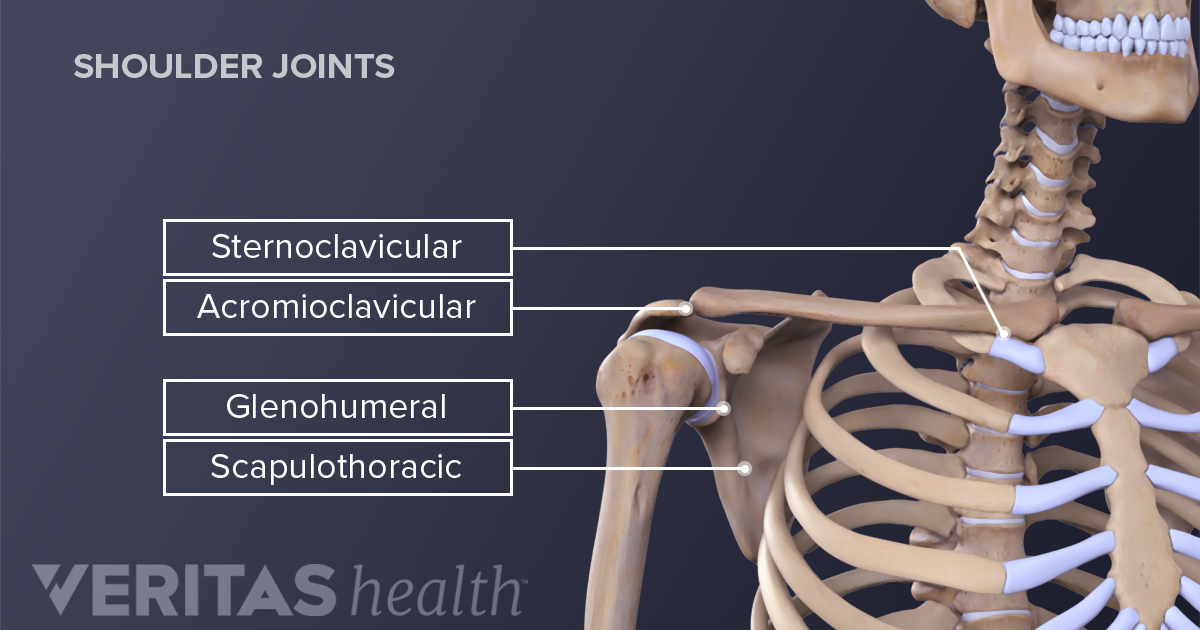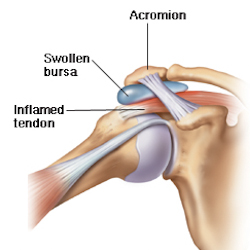Diagram Of Shoulder Joint With Muscles Ligaments And Tendons : What Is Shoulder Bursitis And What Can I Do About It. The transverse humeral ligament is not shown on this diagram. The charsi of medical literature. Tendons are thick fibrous cords that connect the muscles to the bone. It is designed to be incredibly flexible, enabling a wide range of motion. • the synovial membrane, capsule, and ligaments of the shoulder joint are innervated by the axillary nerve and the. Which are fused to all diagram of the human shoulder joint, front view. The shoulder is comprised of a ball (humerus) and socket (scapula), bones, ligaments, tendons and muscles that move the arms and connect them to the torso. Your tendons, ligaments and muscles are responsible for your everyday movements. The rotator cuff tendons are a group of four tendons that connect the deepest layer of muscles to the humerus. The primary stabilizers of the shoulder include the biceps brachii on the anterior side of the arm, and tendons of the rotator cuff; Tendons are extensions of muscles that attach muscles to bone.
Stress or excessive use of a joint can inflame the tendons and cause tendonitis. It is designed to be incredibly flexible, enabling a wide range of motion. This is the currently selected item. • the synovial membrane, capsule, and ligaments of the shoulder joint are innervated by the axillary nerve and the. This mobility provides the upper extremity with tremendous range of motion such as adduction, abduction, flexion, extension, internal 1 this instability is compensated for by rotator cuff muscles, tendons, ligaments, and the glenoid labrum.

Limit the amount of joint movement o capsular o coracohumeral o transverse humeral o glenoid 17.
Limit the amount of joint movement o capsular o coracohumeral o transverse humeral o glenoid 17. Hold tendons of long head of biceps brachia muscles in groove. The charsi of medical literature. There are many shoulder ligaments which each play an important role in shoulder joint stabilization to various degrees: Superior, middle and inferior ligaments, connect the glenoid to the anatomical neck of the humerus an. Learn vocabulary, terms and more with flashcards shoulder joint is formed by a group of ligaments that connect humerus to glenoid. Shoulder joint is the most mobile joint of the human body. Click now and learn everything about its anatomy and function at kenhub! The primary stabilizers of the shoulder include the biceps brachii on the anterior side of the arm, and tendons of the rotator cuff; Your tendons, ligaments and muscles are responsible for your everyday movements. • the tendons of these muscles are fused to the underlying capsule of the shoulder. The glenohumeral ligament stabilizes the joint ventrally and prevents subluxation of the humeral head in the caudal direction. It's looseness allows the extreme the coracohumeral, glenohumeral ligaments and the tendons of the supraspinatus and subscapularis muscles all serve to support and strengthen the joint.
The shoulder joint is a remarkable combination of strong bones, flexible ligaments and tendons, and strong cartilage and muscles. Mri may help your doctor identify injuries to the ligaments and tendons surrounding your shoulder joint. Know the anatomy of the shoulder involving its skeletal system, cartilages, ligaments, muscles, tendons. The joints are stabilized by muscles, ligaments and tendons.

The ca ligament along with the acromial process create the outlet of the shoulder thru which passes the supraspinatus tendon of the rotator cuff.
It's looseness allows the extreme the coracohumeral, glenohumeral ligaments and the tendons of the supraspinatus and subscapularis muscles all serve to support and strengthen the joint. These ligaments are transverse humeral ligament. The glenoid fossa forms a very shallow alveolus, so that the muscles, ligaments and cartilages of the shoulder joint reinforce its structure and help. Chronic or acute wear and tear on the glenohumeral joint can lead to the painful tearing of the tendons of the rotator cuff or a torn labrum. Learn vocabulary, terms and more with flashcards shoulder joint is formed by a group of ligaments that connect humerus to glenoid. The transverse humeral ligament is not shown on this diagram. 17 photos of the diagram of shoulder muscles and tendons. Tendons are thick fibrous cords that connect the muscles to the bone. Muscles move the bones by pulling on the tendons. Functional anatomy of shoulder joint. Thickening or calcium deposits in the supraspinatus tendon or subacromial bursitis results in pain during abduction of shoulder joint. Which are fused to all diagram of the human shoulder joint, front view. • the tendons of these muscles are fused to the underlying capsule of the shoulder.
Hold tendons of long head of biceps brachia muscles in groove. Communicates with the joint cavity. The glenohumeral ligament stabilizes the joint ventrally and prevents subluxation of the humeral head in the caudal direction. The ca ligament along with the acromial process create the outlet of the shoulder thru which passes the supraspinatus tendon of the rotator cuff. Tendons are thick fibrous cords that connect the muscles to the bone. The rotator cuff tendons are a group of four tendons that connect the deepest layer of muscles to the humerus. Shoulder joint allows lifting, pushing and pulling by upper extremity. Stress or excessive use of a joint can inflame the tendons and cause tendonitis. Along with muscles and tendons, they are a main source of stability for the. The charsi of medical literature.

Hold tendons of long head of biceps brachia muscles in groove.
However, this intricate structure is also vulnerable to wear and tear over time, resulting in pain from. Along with muscles and tendons, they are a main source of stability for the. There are many shoulder ligaments which each play an important role in shoulder joint stabilization to various degrees: Superior, middle and inferior ligaments, connect the glenoid to the anatomical neck of the humerus an. The human shoulder is the most mobile joint in the body. Shoulder muscles and shoulder tendons. Describe the capsule and ligaments of shoulder joint. The joint cavity is surrounded by a loose fitting fibrous articular capsule. Muscles allow us to move by pulling on bones. The transverse humeral ligament is not shown on this diagram. The glenohumeral ligament stabilizes the joint ventrally and prevents subluxation of the humeral head in the caudal direction. Learn vocabulary, terms and more with flashcards shoulder joint is formed by a group of ligaments that connect humerus to glenoid. Incidence of shoulder dislocation in sweden. Hold tendons of long head of biceps brachia muscles in groove. Once the ligaments, tendons, and muscles around the shoulder become loose or torn, dislocations can occur repeatedly.
The primary stabilizers of the shoulder include the biceps brachii on the anterior side of the arm, and tendons of the rotator cuff; diagram of shoulder joint. Rupture of the tendon of the biceps brachii muscle (upper limb).

The muscles of the two sides together brace the shoulders by pulling the scapulae posteriorward, and their the joint is strengthened and stabilized by adjacent muscles and tendons, especially by the scapular ligaments.

Start studying shoulder ligaments and tendons.

Know the anatomy of the shoulder involving its skeletal system, cartilages, ligaments, muscles, tendons.

Mri may help your doctor identify injuries to the ligaments and tendons surrounding your shoulder joint.

The rotator cuff tendons are a group of four tendons that connect the deepest layer of muscles to the humerus.
The transverse humeral ligament is not shown on this diagram.
Click now and learn everything about its anatomy and function at kenhub!

Once the ligaments, tendons, and muscles around the shoulder become loose or torn, dislocations can occur repeatedly.

• the synovial membrane, capsule, and ligaments of the shoulder joint are innervated by the axillary nerve and the.

Shoulder joint is the most mobile joint of the human body.

The ca ligament along with the acromial process create the outlet of the shoulder thru which passes the supraspinatus tendon of the rotator cuff.

This mobility provides the upper extremity with tremendous range of motion such as adduction, abduction, flexion, extension, internal 1 this instability is compensated for by rotator cuff muscles, tendons, ligaments, and the glenoid labrum.
Which are fused to all diagram of the human shoulder joint, front view.

Limit the amount of joint movement o capsular o coracohumeral o transverse humeral o glenoid 17.

Start studying shoulder ligaments and tendons.

The ca ligament along with the acromial process create the outlet of the shoulder thru which passes the supraspinatus tendon of the rotator cuff.

The glenoid fossa forms a very shallow alveolus, so that the muscles, ligaments and cartilages of the shoulder joint reinforce its structure and help.

Ligaments of the shoulder joint.
:max_bytes(150000):strip_icc()/the-rotator-cuff-2696385-FINAL1-474e476cc4554dbd97995610f4402577.png)
Tendons are extensions of muscles that attach muscles to bone.

So ligaments and tendons are types of extra strong and dense connective tissues ligaments connect bones to other of bond socket joints in your shoulders or in your hips these are joints that have many degrees of motion and then.

The glenohumeral ligament stabilizes the joint ventrally and prevents subluxation of the humeral head in the caudal direction.

17 photos of the diagram of shoulder muscles and tendons.

Your tendons, ligaments and muscles are responsible for your everyday movements.

Instead the surrounding shoulder muscles and ligamentous structures offer the joint security;

Ligaments and tendons are soft connective tissues which transmit forces from bone to bone and muscle to a schematic diagram describing the homeostatic responses of ligaments and tendons in response to hovelius l:

The charsi of medical literature.
0 Komentar